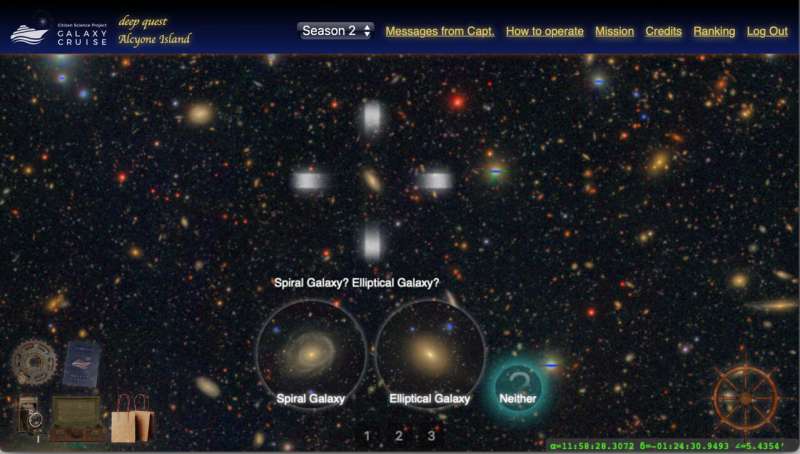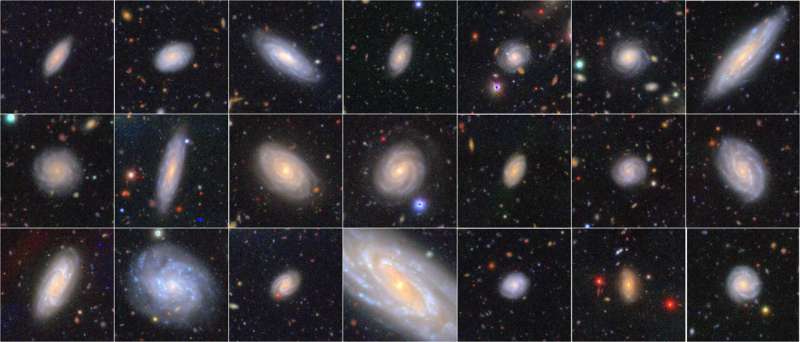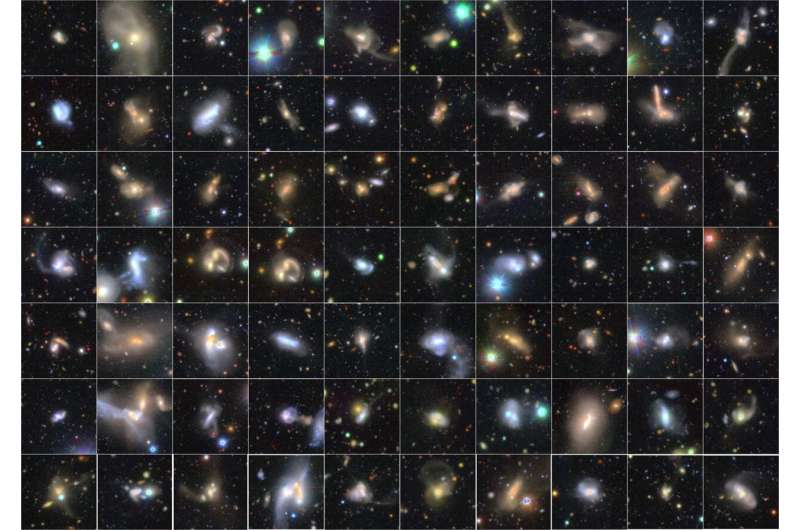This article has been reviewed according to Science X's editorial process and policies. Editors have highlighted the following attributes while ensuring the content's credibility:
fact-checked
trusted source
proofread
First scientific results from Galaxy Cruise

Galaxy Cruise, a citizen science project led by the National Astronomical Observatory of Japan (NAOJ), has been sailing the cosmic ocean with citizen astronomers to uncover the secrets of galaxies since 2019.
Using the deep, high-quality images from the Subaru Telescope combined with high-accuracy classifications of galaxies provided by the citizen astronomers, professional researchers unambiguously confirmed that galaxies become more active when they collide and merge with other galaxies. This result is reported in the first scientific paper from Galaxy Cruise. The citizen astronomers' classifications are made available to the public so that astronomers from all over the world can use them to make new discoveries.
This work was published online in Publications of the Astronomical Society of Japan on September 26, 2023, titled "Galaxy Cruise: Deep Insights into Interacting Galaxies in the Local Universe."
The universe is filled with a wide variety of galaxies; some galaxies are red elliptical galaxies, while others are blue spiral galaxies. There are also galaxies without well-defined shapes. This diversity is thought to arise from collisions and mergers between galaxies over cosmic timescales. However, the exact roles of collisions and mergers have remained poorly understood because interacting galaxies are rare objects and are thus difficult to find.
To overcome this difficulty, Galaxy Cruise called for help from citizen astronomers to identify interacting galaxies from the deep images taken with Hyper Suprime-Cam (HSC) installed on the Subaru Telescope.
Citizen astronomers are by no means professional astronomers, but can they classify galaxies? Yes, they can! Professional astronomers show them how. Citizen astronomers are asked to go through a training course to understand the fundamentals of galaxy morphology. Once they pass the course, they get a boarding pass for Galaxy Cruise.
Many citizen astronomers got onboard and were captivated by the diversity of galaxies in the universe. About 10,000 citizen astronomers explored the universe and made more than 2 million classifications in the first 2.5 years of Galaxy Cruise. Such a large number of classifications would not have been possible by professional astronomers alone.

Dr. Masayuki Tanaka, the "Captain" of Galaxy Cruise, carefully analyzed the citizen scientists' classifications and found that the citizen astronomers classified galaxies very well. Figure 2 illustrates the accuracy. The quality of the HSC images is essential for the high classification accuracy; there are many galaxies that were classified as elliptical galaxies in previous studies, but they turn out to exhibit clear spiral arms in the deeper HSC images. "The classification accuracy of Galaxy Cruise surpasses previous studies," says Tanaka.
The same applies to interacting galaxies, which are the focus of Galaxy Cruise. When galaxies collide and merge, they often show distorted shapes with characteristic features around them such as tidal tails. These features are often diffuse and faint and can easily be missed. However, thanks to the high sensitivity and high angular resolution of the HSC images, Galaxy Cruise successfully captured these faint features.
The citizen astronomers discovered that many of the 'normal' (i.e., non-interacting) galaxies reported in the previous studies actually exhibit signs of interaction. In addition, citizen astronomers identified galaxies that are currently undergoing violent mergers.

Figure 3 showcases these violent mergers. They all show significantly distorted shapes with very complex structures. Such violent mergers are extremely rare and a statistical sample of such galaxies illustrates the power of visual classifications by a large number of citizen astronomers.
The sample of interacting galaxies revealed that these galaxies show an enhanced level of star formation activity (Note 1) compared to normal galaxies. Furthermore, super massive black holes are also found to be more active. Interestingly, this activity is most significantly enhanced in violent mergers like those shown in Figure 3.
It is likely that the final coalescence of a merger event is the moment when the internal activity of galaxies is most strongly enhanced. These interesting results were published in a scientific paper. This is the first paper from Galaxy Cruise and is a milestone not just for astronomers but also the participating citizen astronomers.
"There have been a lot of efforts trying to understand the star formation and black hole activities of merging galaxies," says Tanaka. "However, researchers have often reached contradicting results. This is likely due to the difficulties in identifying merging galaxies, differences in the definition of mergers, differences in the way the galaxies are analyzed, etc. Galaxy Cruise's approach to the problem is the classic visual classification."
"It is a time consuming but powerful method to identify mergers. Combined with the high-quality HSC images, we could construct a better sample of mergers than before and it led us to confirm unambiguously that mergers enhance the internal activities of galaxies. This is an extremely exciting result and it would not have been possible without the participation of so many citizen astronomers."
Galaxy Cruise's classification catalog has been released to the public together with the publication of the paper. The high-quality classifications will be further exploited by professional astronomers from all over the world. The catalog will hopefully lead them to new discoveries.
"People may think that scientific work is only for professional researchers. That is not necessarily the case. Public citizens can certainly contribute as Galaxy Cruise demonstrated. Galaxy Cruise is still on its continuing voyage. Why not join us? I am looking forward to welcoming you on board and solving the mysteries of galaxies together," Captain Tanaka concludes.
More information: Masayuki Tanaka et al, Galaxy Cruise: Deep Insights into Interacting Galaxies in the Local Universe, Publications of the Astronomical Society of Japan (2023). DOI: 10.1093/pasj/psad055
Provided by Subaru Telescope




















